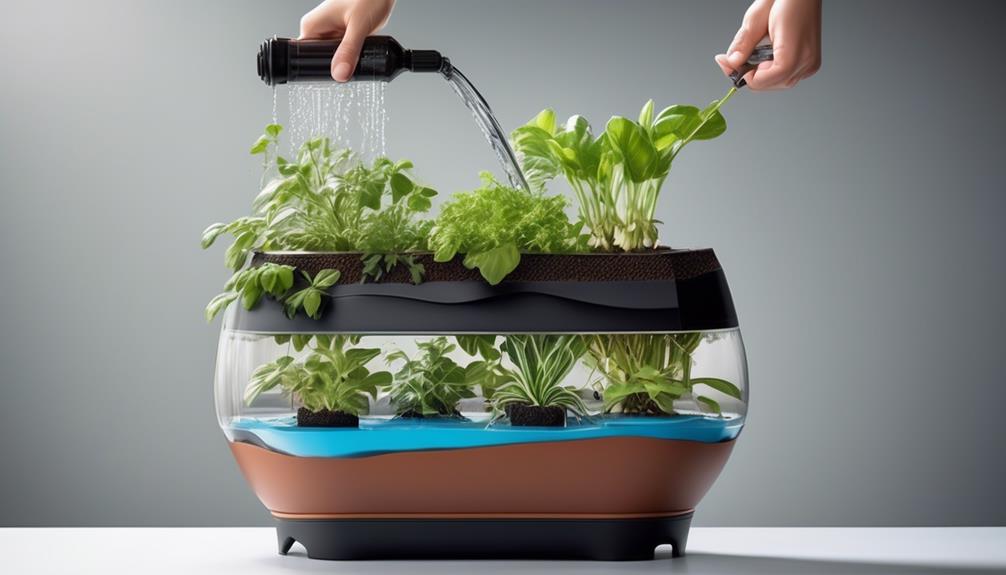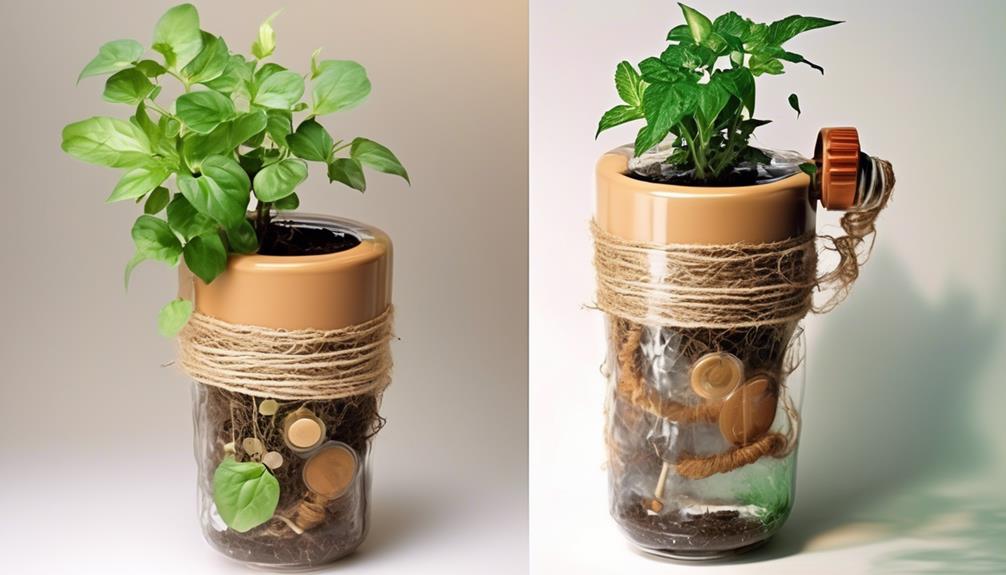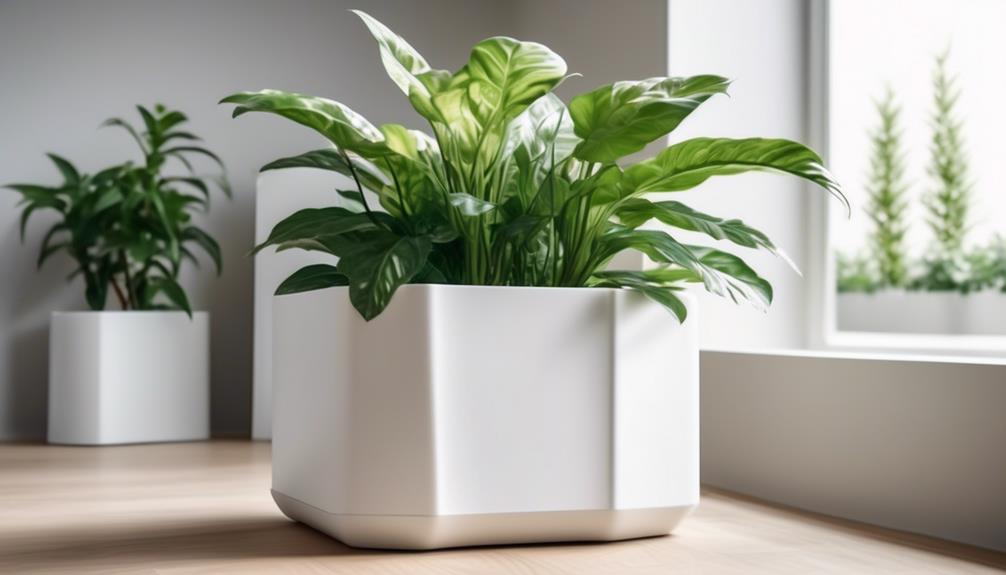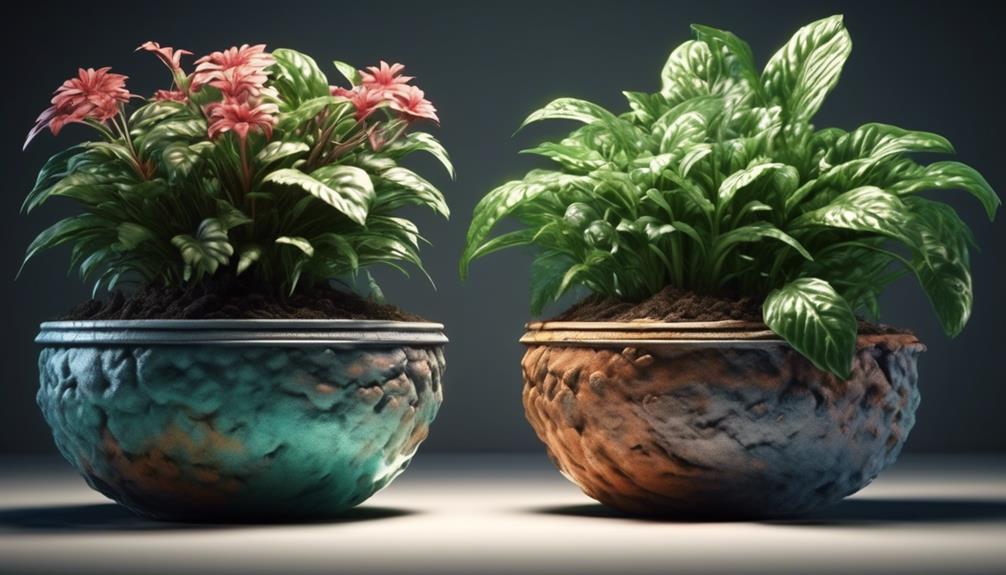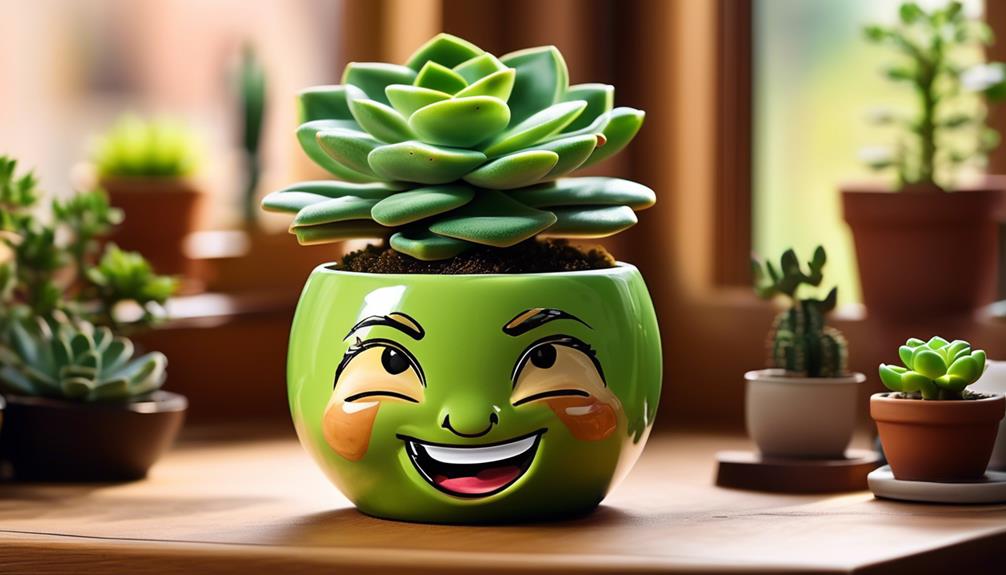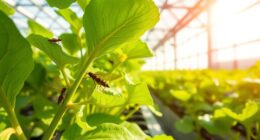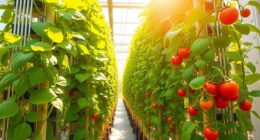Have you ever considered how a self-watering planter could enhance the growth and health of your plants?
It's fascinating to learn that these innovative containers can reduce water usage by up to 80% compared to traditional planters.
But how exactly does this technology work? Let's explore the science behind self-watering pots and uncover the secrets to their efficient water delivery system.
Key Takeaways
- Self-watering pots reduce water usage by up to 80% compared to traditional planters.
- Capillary action enables consistent moisture supply to plant roots and prevents overwatering or underwatering.
- The reservoir function regulates soil moisture levels and provides a stable and balanced environment for plant roots.
- The selection of wicking material plays a crucial role in efficient water delivery in self-watering pots.
Self-Watering Pot Overview
Self-watering pots, also known as self-watering planters, function by utilizing a reservoir system to provide a consistent and controlled watering supply to plants, ensuring optimal moisture levels for healthy growth.
These innovative planters offer several benefits. Firstly, they prevent overwatering, a common problem in traditional plant pots, by allowing plants to uptake water as needed through capillary action. This helps maintain ideal hydration levels, minimizing the risk of root rot and other water-related issues.
Additionally, self-watering pots provide a buffer against under-watering, as the reservoir ensures a steady supply of water, especially beneficial for forgetful or busy gardeners.
Moreover, they support plant hydration techniques by promoting deep root growth. Unlike conventional watering methods that often lead to shallow root systems, self-watering pots encourage plants to develop extensive root networks as they naturally seek out moisture from the reservoir at the bottom of the pot. This results in stronger, healthier plants with improved stability and resilience.
Capillary Action
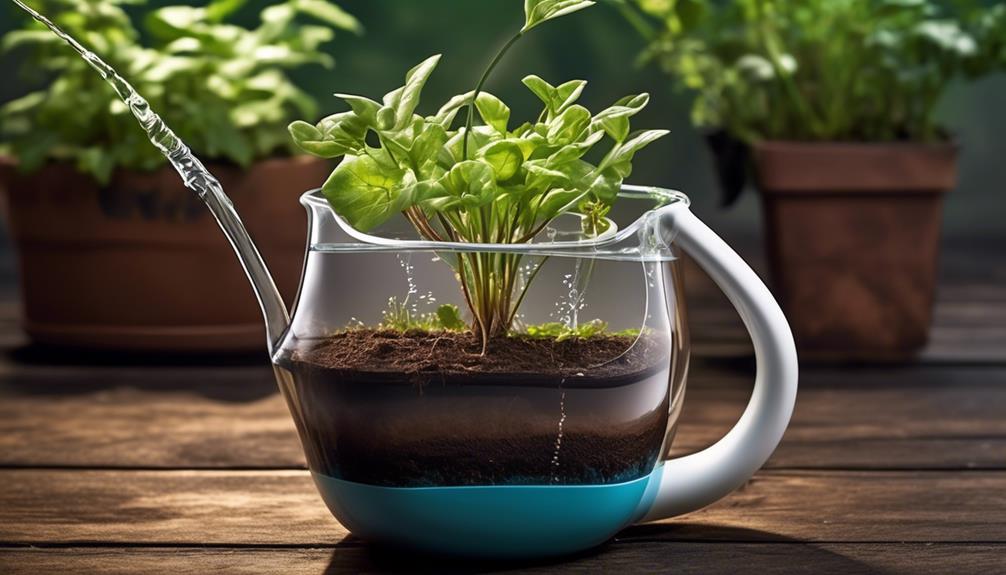
Capillary action is a fundamental process that allows water to move through porous materials, such as soil or a potting medium.
This phenomenon occurs due to the adhesive and cohesive forces between the water and the material, enabling the water to defy gravity and rise upwards.
Understanding capillary action is crucial to grasp the mechanism behind the self-watering pot's ability to provide consistent moisture to plants, making it a key element in the efficient and effective functioning of these innovative containers.
Capillary Action Explanation
The process of water being drawn upwards through narrow spaces in a material, such as soil or a porous medium, is known as capillary action. Capillary action occurs due to the cohesive and adhesive properties of water.
Water molecules are attracted to each other (cohesion) and to the material they're in contact with (adhesion), causing them to move upward against the force of gravity.
In the context of a self-watering pot, capillary action enables the soil or growing medium to absorb water from the reservoir through small passageways. This water absorption provides the plant roots with a consistent moisture supply, promoting healthy growth and hydration.
Additionally, capillary action aids in moisture retention within the growing medium, ensuring that the plant's root system has access to water as needed.
Benefits of Capillary Action
Indisputably, the phenomenon of capillary action plays a crucial role in ensuring a consistent and reliable water supply to the roots of plants in self-watering pots. The benefits of capillary action are truly remarkable:
- Efficient Soil Hydration: Capillary action allows water to move upwards through the soil, ensuring that the entire root system receives adequate moisture, promoting optimal plant growth.
- Prevention of Overwatering or Underwatering: Capillary action helps maintain a balanced moisture level in the soil, preventing the risk of overwatering or underwatering, which can negatively impact plant health.
- Stress-Free Plant Care: With capillary action, self-watering pots enable a more hands-off approach to plant care, providing a consistent and reliable water supply, reducing the need for constant monitoring.
Understanding the benefits of capillary action enhances our mastery of self-watering pots and fosters an appreciation for the intricate mechanisms that facilitate healthy plant growth.
Reservoir Function
The reservoir function in a self-watering pot is crucial for maintaining optimal soil moisture levels.
The water level indicator allows us to monitor the amount of water in the reservoir, ensuring that the plant receives just the right amount of hydration.
The capillary action mechanism then draws water from the reservoir into the soil, regulating moisture levels and providing a consistent water supply to the plant roots.
Water Level Indicator
Using a simple yet effective mechanism, the water level indicator in the self-watering pot ensures that the reservoir maintains an optimal water level for the plant.
The indicator consists of a transparent tube with markings that indicate the water level inside the reservoir. When the water level drops, the indicator visually signals the need for a refill.
This simple but ingenious design allows us to easily monitor the water level without the need for frequent manual checks. It provides peace of mind, ensuring that the plant's hydration needs are consistently met.
This technology empowers plant enthusiasts to maintain the reservoir at the ideal water level, contributing to the overall health and vitality of the plant.
The water level indicator simplifies the process of water level maintenance, providing a reliable solution for efficient plant hydration techniques.
Capillary Action Mechanism
Utilizing the principle of capillary action, the self-watering pot's reservoir functions by drawing water upwards through the soil, ensuring consistent moisture for the plant.
The capillary action mechanism relies on the cohesive and adhesive properties of water and the porous nature of the soil.
As the soil dries out, water from the reservoir moves into the soil through capillary action, allowing the roots to absorb water as needed.
This water absorption process is facilitated by the tiny spaces between soil particles, which create capillary channels for water to move upward.
The capillary action mechanism ensures that the plant's root system has access to water at all times, promoting healthy growth and reducing the risk of over or under-watering.
Understanding the intricacies of capillary action is essential for effectively utilizing the self-watering pot's reservoir function to maintain optimal plant hydration.
Soil Moisture Regulation
Drawing water upwards through the soil, our self-watering pot's reservoir regulates soil moisture by maintaining consistent hydration for the plant. This function is crucial for the plant's health and growth, as it ensures optimal soil moisture retention and minimizes the need for frequent watering.
The reservoir system operates by utilizing capillary action, allowing water to move from the reservoir into the soil as needed. This mechanism effectively prevents overwatering or underwatering, providing a stable and balanced environment for the plant's roots.
Additionally, the self-regulating nature of the reservoir function reduces the watering frequency, offering peace of mind to plant owners and ensuring a more stable and controlled growth environment for the plant.
Wicking Material
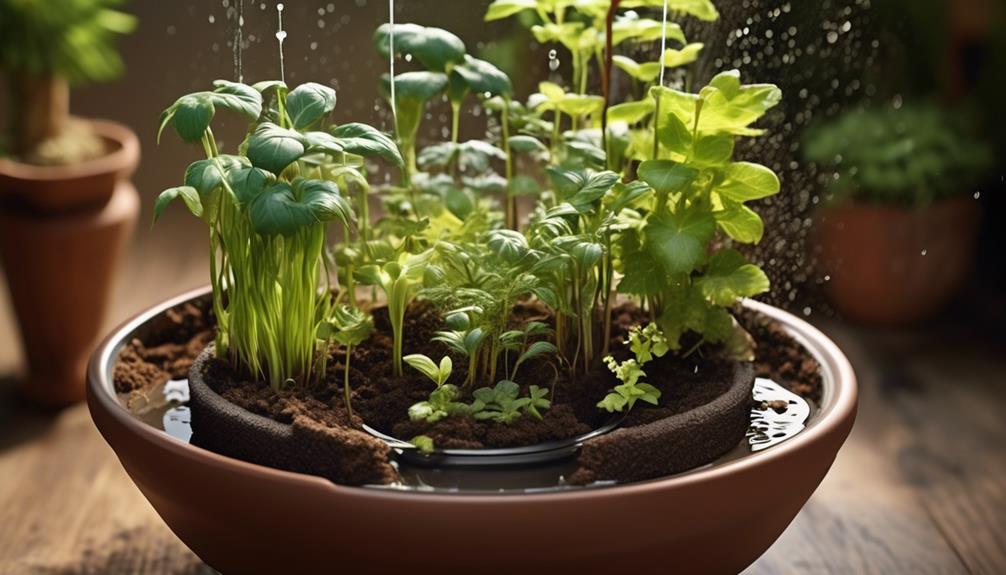
To efficiently transport water from the reservoir to the soil, the self-watering pot utilizes a highly absorbent wicking material. This material is essential for maintaining proper moisture levels in the soil, ensuring optimal growing conditions for plants. The wicking material properties are crucial for its effectiveness in this system. It needs to have high absorbency, allowing water to move upward through capillary action. Additionally, the material must be durable and resistant to degradation, as it will be in constant contact with moisture.
| Wicking Material Properties | Wicking Material Alternatives |
|---|---|
| High absorbency | Capillary mat |
| Durability | Cotton rope |
| Resistance to degradation | Polyester wicks |
| Capillary action | Nylon fabric |
| Consistent water transport | Felt strips |
While there are various wicking material alternatives, each with its own unique properties, the selection depends on factors such as the size of the pot, the type of plants being grown, and the specific requirements of the self-watering system. Overall, the wicking material plays a crucial role in ensuring the efficient and consistent delivery of water to the soil, promoting healthy plant growth.
Root Zone Hydration
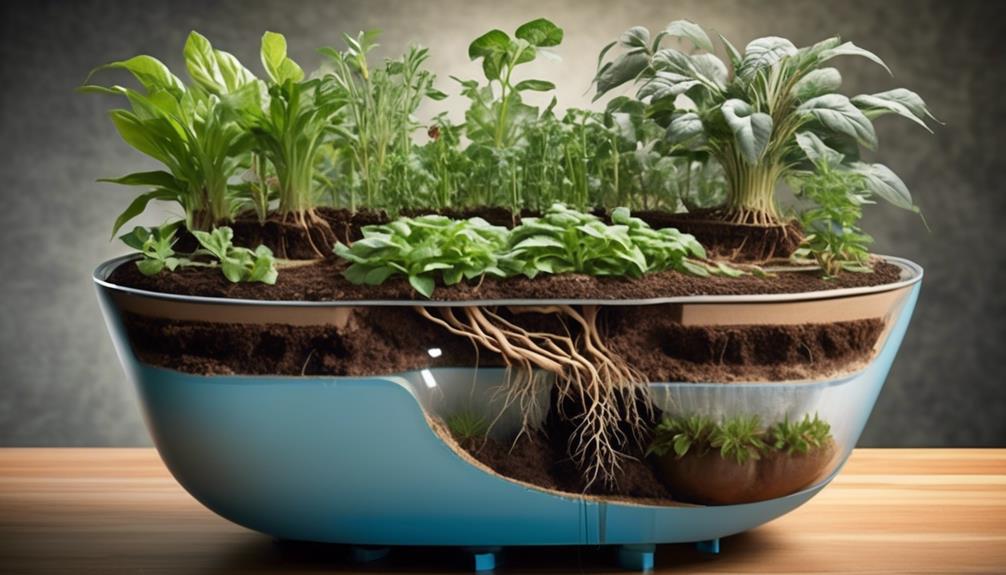
For efficient root zone hydration, the self-watering pot system employs a mechanism that ensures consistent and adequate moisture levels within the soil. This mechanism involves maintaining a balanced water reservoir and utilizing capillary action to deliver water directly to the root zone.
The following points explain the technical aspects of root zone hydration and the importance of this process for plant health:
- Capillary Action: The self-watering pot utilizes a wicking material to transport water from the reservoir to the root zone through capillary action. This ensures that the plant's roots have continuous access to moisture, promoting optimal root zone health and growth.
- Moisture Regulation: By maintaining a steady supply of water to the root zone, the self-watering pot system prevents under or over-watering, which are common issues in traditional watering methods. This precise regulation of moisture levels enhances the overall health and vitality of the plant.
- Optimal Growth Conditions: Consistent root zone hydration is essential for supporting the plant's metabolic processes, nutrient uptake, and overall growth. The self-watering pot system provides a stable environment for the roots, promoting robust and healthy plant development.
Understanding the intricacies of root zone hydration and the role it plays in plant hydration techniques is crucial for mastering the art of cultivating thriving and resilient plants.
Evaporation Control

An efficient approach to controlling evaporation in the self-watering pot system involves the utilization of a specialized cover to minimize moisture loss from the soil. Evaporation control is critical for water conservation and maintaining optimal soil moisture levels.
The specialized cover, often made of plastic or other impermeable materials, acts as a barrier, reducing the amount of water lost to evaporation from the soil surface. This cover helps create a microclimate within the pot, minimizing the escape of moisture into the surrounding environment.
In addition to the cover, the design of the self-watering pot also plays a crucial role in evaporation control. The pot is engineered to minimize exposure of the soil to the air, further reducing evaporation. By creating a closed system where water is delivered directly to the roots and the soil is shielded from direct contact with the air, evaporation is significantly minimized.
Furthermore, the self-watering pot's wicking system, which draws water from the reservoir to the soil as needed, ensures that the soil remains consistently moist without excessive evaporation. This integrated approach to evaporation control not only conserves water but also promotes optimal plant hydration and growth.
Water Level Indicator
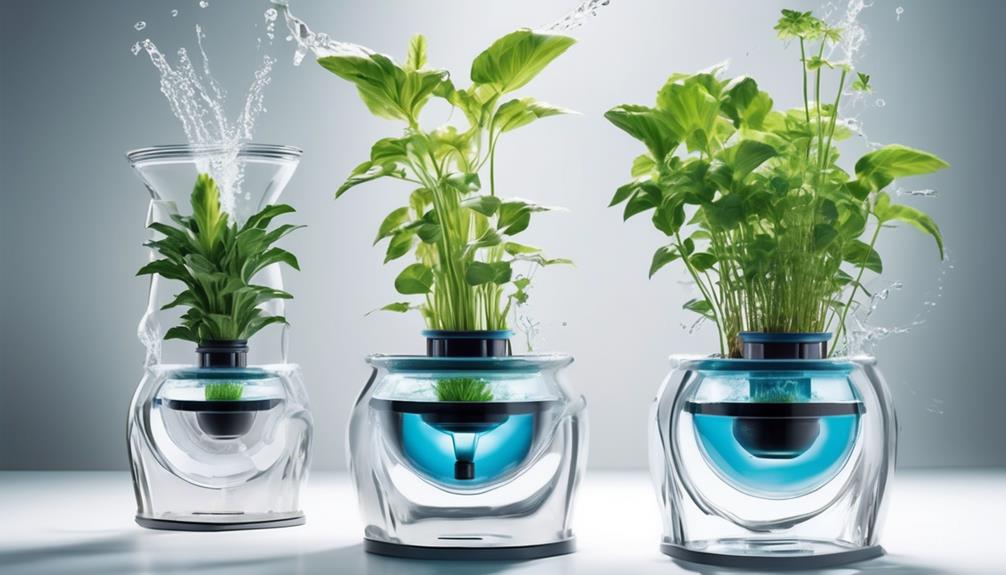
The efficient control of evaporation in the self-watering pot system lays the foundation for the next crucial aspect: the water level indicator, which plays a pivotal role in monitoring and managing the reservoir's water supply.
The water level indicator is a key component of the self-watering pot, providing a visual or digital display to show the current water level in the reservoir. This indicator allows users to easily determine when the water level is low and requires refilling, ensuring that plants receive a consistent water supply.
The convenience and peace of mind provided by the water level indicator help users maintain a healthy watering schedule without the need for constant monitoring. This technology alleviates the worry of under or overwatering, fostering a sense of empowerment and confidence in caring for plants.
Additionally, the ability to make precise water level adjustments based on the indicator's readings further enhances the user's control over the watering process. With the water level indicator, users can confidently tailor the watering schedule to meet the specific needs of their plants, promoting optimal growth and overall plant well-being.
Oxygenation Process
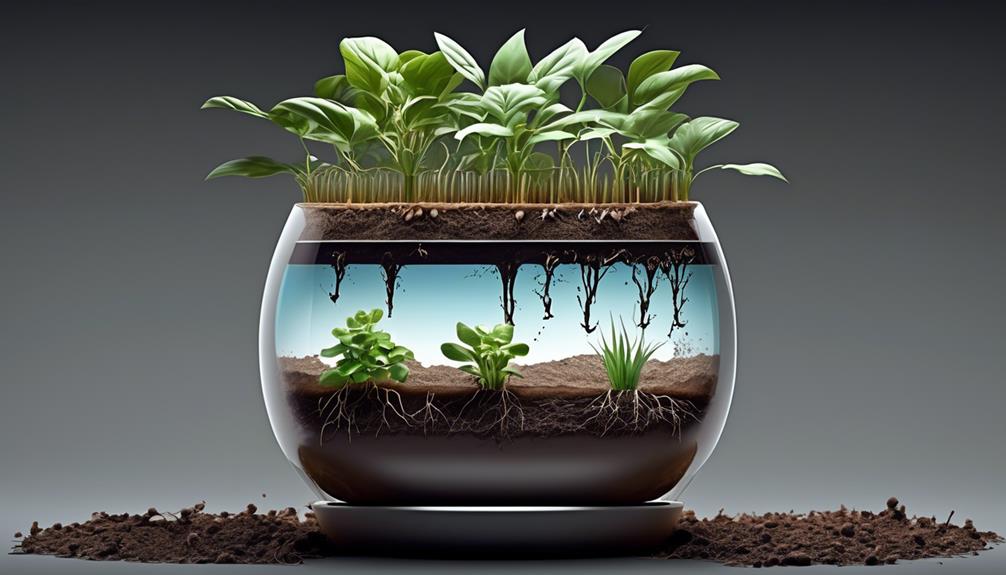
When it comes to the oxygenation process in a self-watering pot, it's crucial to understand how oxygen moves through the soil and interacts with the plant roots.
The air circulation system within the pot plays a key role in ensuring that oxygen reaches the root zone, promoting healthy growth.
Additionally, the root aeration process, facilitated by the design of the pot, further enhances the oxygenation of the plant's root system.
Oxygenation Through Soil
To properly understand the oxygenation process through soil in a self-watering pot, it's essential to comprehend the dynamic relationship between root respiration and the movement of air within the soil.
Soil aeration is crucial for the oxygenation process as it allows the movement of air into the soil, facilitating the exchange of gases necessary for plant growth. This process is vital for the roots to receive the oxygen they need to carry out cellular respiration, a fundamental process for plant survival.
Additionally, soil aeration contributes to the overall health of the plant and plays a significant role in nutrient uptake. Understanding the intricacies of soil aeration and the oxygenation process can evoke a sense of mastery and appreciation for the delicate balance that supports plant life.
Air Circulation System
Facilitating the exchange of gases within the soil, the air circulation system in a self-watering pot plays a vital role in providing essential oxygen to the roots for cellular respiration and nutrient uptake.
This system comprises of air vents or porous materials within the pot design, allowing for the movement of air between the soil and the surroundings.
As water is absorbed by the soil and the plant utilizes it, the air circulation system ensures that the root zone doesn't become waterlogged, preventing the occurrence of anaerobic conditions detrimental to root health.
Proper air circulation also helps to regulate watering frequency by preventing excessive moisture buildup, thereby promoting a balanced soil moisture level ideal for plant growth.
The efficient exchange of gases through the air circulation system is crucial for maintaining a healthy and oxygen-rich environment around the roots.
Root Aeration Process
In a self-watering pot, the root aeration process, also known as the oxygenation process, is essential for maintaining an oxygen-rich environment around the roots to support cellular respiration and nutrient uptake. This process is crucial for plant health and involves the following:
- Efficient Oxygen Delivery: The self-watering pot's design ensures that oxygen is efficiently delivered to the roots, promoting healthy growth and development.
- Prevention of Root Rot: By facilitating adequate oxygenation, the risk of root rot is significantly reduced, ensuring the overall well-being of the plant.
- Enhanced Nutrient Absorption: Proper root aeration promotes enhanced nutrient absorption, leading to stronger and more vibrant plants.
Understanding the intricacies of root aeration is fundamental for mastering the art of plant care and ensuring optimal growth and vitality.
Preventing Waterlogging

When designing a self-watering pot, the prevention of waterlogging is a crucial consideration in order to maintain optimal soil moisture levels for plant growth. To prevent waterlogging, efficient drainage solutions are essential.
One common method is to incorporate a reservoir with a water level indicator and a wicking system into the design. The reservoir holds the excess water, while the water level indicator helps in monitoring the water level to prevent overfilling. The wicking system, usually made of a permeable material, draws water from the reservoir to the soil as needed, ensuring that the soil moisture remains at an ideal level without becoming waterlogged.
In addition to the reservoir and wicking system, the self-watering pot should also include drainage holes and aeration features to prevent water from stagnating in the soil. Properly positioned drainage holes allow excess water to drain out of the soil and into the reservoir, preventing waterlogging. Aeration features, such as air vents or porous materials, promote oxygen circulation within the soil, preventing anaerobic conditions that can lead to waterlogging.
Nutrient Delivery
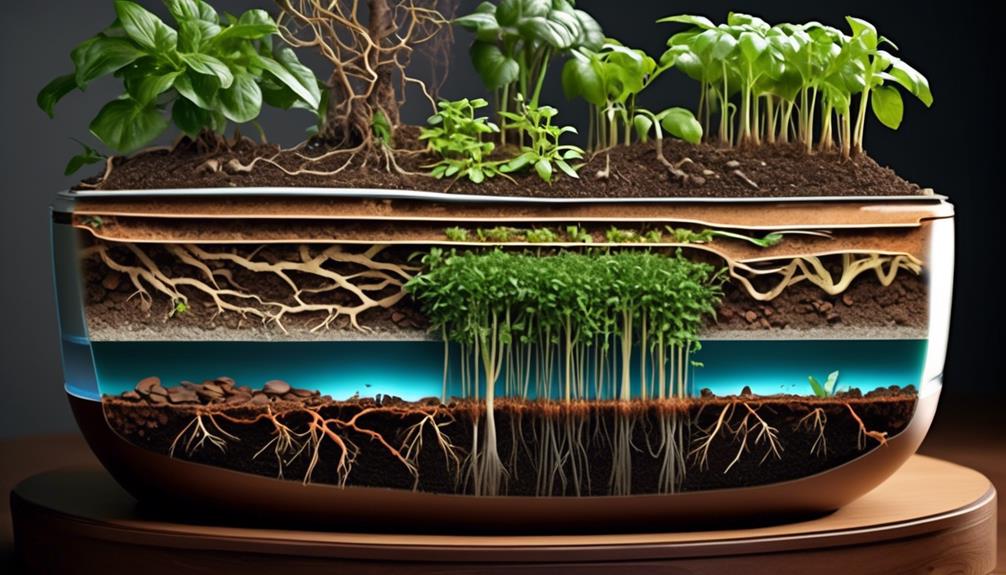
To ensure optimal plant growth, the self-watering pot employs a nutrient delivery system that facilitates the efficient transport of essential plant nutrients to the root zone. The system works by utilizing capillary action and osmosis to deliver water and nutrients directly to the plant's roots. This promotes healthy nutrient absorption and supports the plant's overall growth strategies.
- Increased Nutrient Absorption: The self-watering pot ensures that the plant roots have constant access to water and nutrients, promoting enhanced nutrient absorption. This leads to lusher foliage and vibrant blooms, evoking a sense of pride and satisfaction in the plant owner.
- Optimized Plant Growth Strategies: By providing a consistent and controlled supply of nutrients, the self-watering pot supports the plant's growth strategies, encouraging strong root development and vigorous growth. This fosters a sense of achievement and fulfillment as the plant flourishes and thrives under optimal conditions.
- Healthy, Thriving Plants: The nutrient delivery system of the self-watering pot ultimately results in healthier, more robust plants. Witnessing the lush greenery and abundant blossoms evokes a deep sense of joy and satisfaction, making the gardening experience truly rewarding.
Suitable Plant Types

When choosing suitable plant types for a self-watering pot, it's important to consider factors such as the plant's water requirements and the watering mechanism of the pot.
Certain plants, like African violets and peace lilies, thrive in self-watering pots due to their moderate water needs and ability to wick water from the reservoir as needed.
Understanding the specific watering needs of different plant types is crucial for successful growth in a self-watering pot.
Plant Selection
Suitable plant types for self-watering pots should be chosen based on their water requirements, root size, and growth habits to ensure successful and healthy growth within the specific environment provided by the self-watering system. When selecting plants for self-watering pots, it's important to consider:
- Water Requirements:
Choose plants with similar water needs to ensure proper hydration without overwatering or underwatering, promoting optimal growth and health.
- Root Size:
Select plants with moderate root systems that can efficiently utilize the water supply without becoming root-bound, ensuring balanced growth and development.
- Growth Habits:
Opt for plants with compact growth habits that are well-suited for container gardening, enhancing the aesthetic appeal and overall success of the self-watering pot system.
Careful consideration of these factors will lead to an emotionally satisfying and successful plant care experience with efficient watering techniques.
Watering Mechanism
Selecting the appropriate plant types for the self-watering pot's watering mechanism involves a careful consideration of their water requirements, root size, and growth habits to ensure optimal performance and plant health.
The watering efficiency of the self-watering pot is best suited for plants that prefer consistently moist soil, such as ferns, peace lilies, and spider plants. These plants thrive in environments with stable moisture levels, making them well-suited for the self-watering mechanism.
Additionally, plants with moderate to large root systems, like herbs, African violets, and certain types of succulents, can benefit from the self-watering pot's efficient hydration system.
Understanding the water needs and root characteristics of different plant types is crucial for maximizing the effectiveness of the self-watering pot's watering mechanism and ensuring the overall health and vitality of the plants.
Maintenance Tips
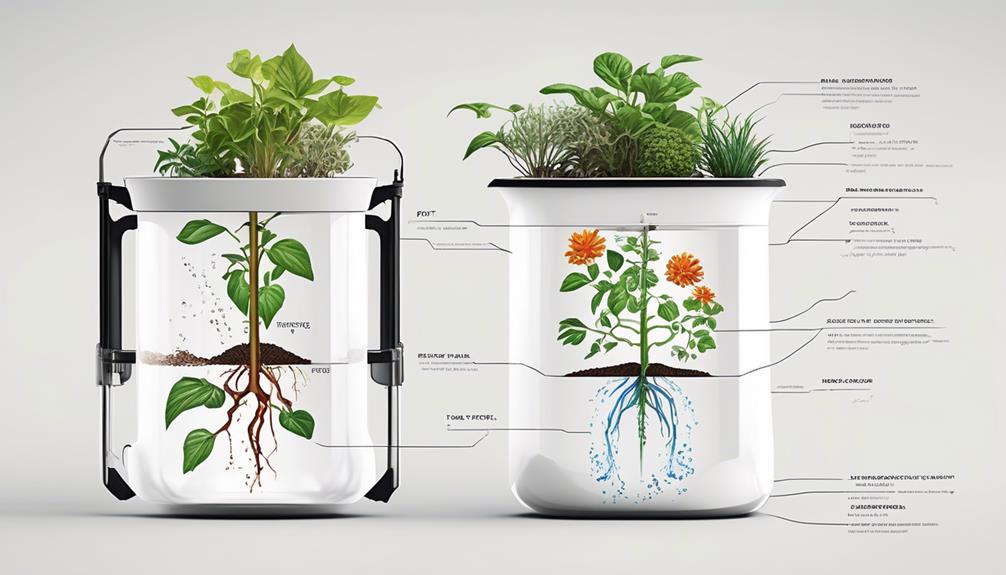
To maintain the self watering pot, regularly check the water level and refill as needed to ensure consistent moisture for the plants. Proper maintenance is crucial for the well-being of your plants and the effectiveness of the self watering pot.
Here are some maintenance tips to help you keep your self watering pot in optimal condition:
- Monitor Soil Moisture: Regularly check the soil moisture to ensure it's at the appropriate level for your specific plants. Adjust the watering frequency based on the moisture requirements of the plants.
- Inspect the Watering System: Periodically inspect the watering system to ensure it's functioning properly. Clean the watering mechanism to prevent clogs and ensure a steady flow of water to the plants.
- Prune and Trim: Keep an eye on the growth of your plants and prune or trim them as needed. This won't only maintain the aesthetic appeal of your plants but also promote healthy growth.
DIY Self-Watering Pot
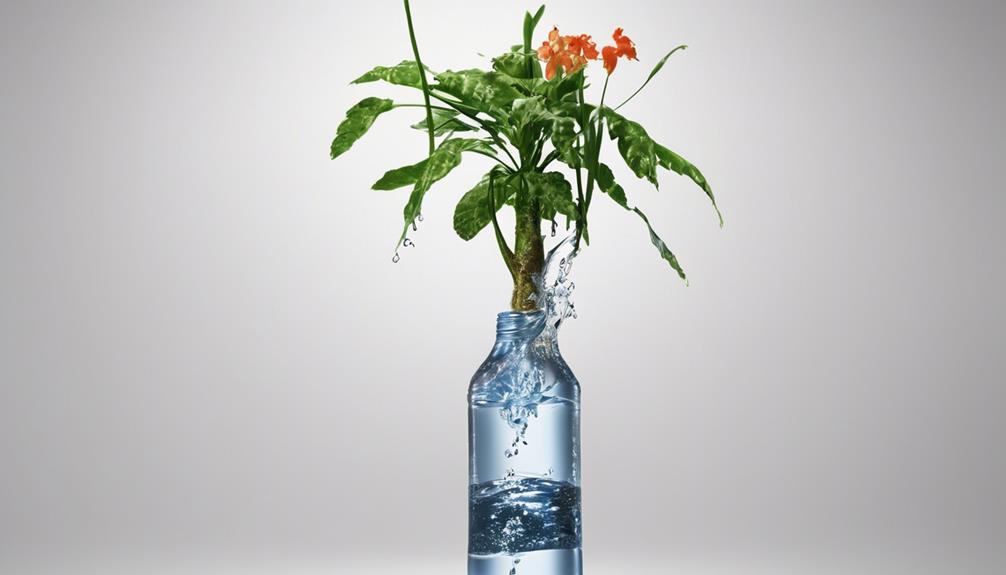
We can easily create a self-watering pot using common household items and a straightforward design.
To make a DIY self-watering pot, start with two identical containers, one slightly smaller than the other. The larger container will hold the water, while the smaller one will hold the plant and soil.
Drill a small hole in the bottom of the smaller container and thread a piece of string through the hole, leaving one end inside the container and the other end hanging down into the larger container. This string will act as a wick, drawing water from the reservoir into the soil as needed.
Next, fill the larger container with water, place the smaller container inside, and fill it with soil and your chosen plant. The wick will provide moisture to the soil, creating a self-watering system.
When implementing DIY potting techniques, it's crucial to choose the right soil and plant for your self-watering pot. Use a well-draining potting mix to prevent waterlogging and root rot. Additionally, select plants that thrive in consistently moist soil, such as peace lilies, spider plants, or philodendrons.
Following these plant care tips will ensure the success of your DIY self-watering pot.
Environmental Benefits
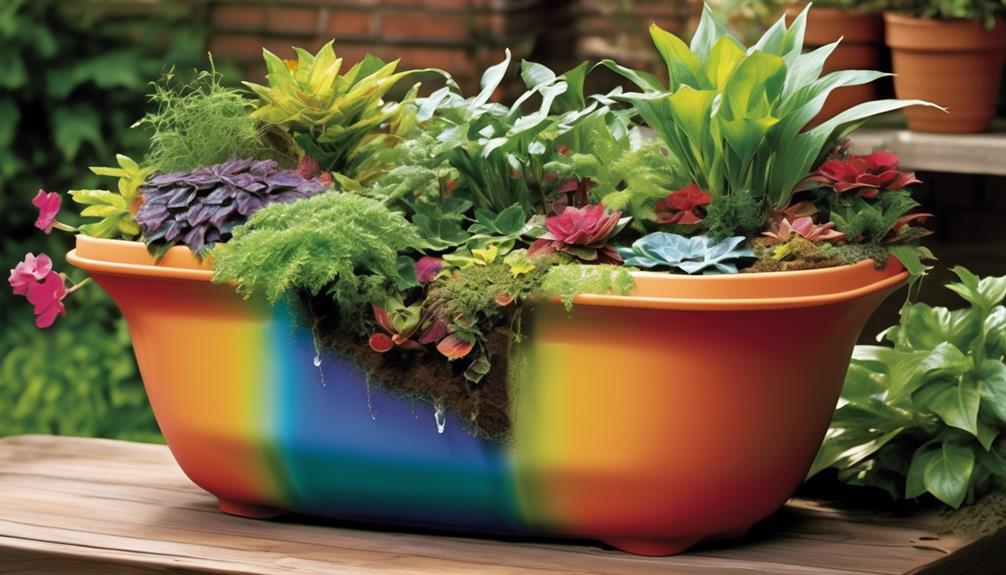
Implementing a self-watering pot system can have significant environmental benefits, reducing water waste and promoting plant health. This innovative watering method contributes to water conservation by minimizing evaporation and runoff, ensuring that plants receive just the right amount of moisture. The self-watering pot's design allows for sustainable gardening practices, as it decreases the frequency of watering, conserves water, and fosters healthier root systems for plants.
Using a self-watering pot helps reduce water usage by up to 80%, benefiting both the environment and our wallets.
Conserving water not only protects our precious natural resources but also supports sustainable living for future generations.
By employing self-watering pots, we can actively contribute to global efforts to combat water scarcity and promote responsible water management.
Sustainable gardening practices, such as utilizing self-watering pots, empower us to cultivate thriving green spaces while minimizing our environmental impact.
Frequently Asked Questions
Can Self-Watering Pots Be Used for Hydroponic Gardening?
Yes, self-watering pots can be used for hydroponic gardening.
Hydroponic systems benefit from the self-watering mechanism, providing consistent moisture without manual watering.
However, self-watering pots have limitations in terms of nutrient delivery and oxygenation compared to traditional hydroponic setups.
Alternative self-watering pot options offer convenience but may not provide the precise control and optimal conditions required for advanced hydroponic gardening.
What Is the Typical Lifespan of a Wicking Material in a Self-Watering Pot?
The typical lifespan of a wicking material in a self-watering pot is like finding a pot of gold at the end of the rainbow – it seems to last forever!
With proper maintenance, the wicking material can endure for years, ensuring consistent moisture distribution in the potting mix.
This longevity not only supports healthy plant growth but also makes self-watering pots an excellent option for hydroponic gardening, offering unparalleled convenience and efficiency.
Are There Any Specific Plants That Should Not Be Grown in a Self-Watering Pot?
We've found that certain plants, like succulents and cacti, may not thrive in self-watering pots due to their lower watering frequency needs. Alternatively, plants that prefer consistently moist soil, such as ferns or peace lilies, are well-suited for self-watering pots.
It's essential to consider plant compatibility when choosing a self-watering pot. Traditional watering methods can be used for plants that may not do well in self-watering pots, or alternative options like clay pots with saucers can provide similar benefits.
How Does the Oxygenation Process in a Self-Watering Pot Affect Plant Growth?
Absolutely, the oxygenation process in a self-watering pot profoundly impacts plant growth. By promoting aeration in the root zone, oxygenation benefits the plants by enhancing nutrient uptake and reducing the risk of root rot.
This essential process supports the growth of healthy, vibrant plants, ensuring optimal conditions for root development and overall plant health.
The resulting boost in plant growth is a direct result of the oxygenation benefits provided by the self-watering pot.
Can Self-Watering Pots Be Used in Outdoor Garden Beds?
Yes, self-watering pots can be utilized in outdoor gardening, particularly for precise soil moisture control. Their design allows for consistent hydration, reducing the risk of over or under-watering.
This is particularly beneficial for outdoor garden beds where environmental conditions can fluctuate. The self-watering pots' water reservoir and wicking system efficiently manage soil moisture, promoting optimal plant growth and health in outdoor settings.
Can I Use a Regular Pot as a Self-Watering Pot?
Yes, you can use a regular pot as a self watering plant pot by simply adding a self watering system. Purchasing an insert or making your own out of a plastic bottle can transform any pot into a self watering plant pot, helping to keep your plants healthy and hydrated.
Conclusion
In conclusion, the self-watering pot uses capillary action and a reservoir to provide a consistent supply of water to plant roots. This innovative design allows for optimal hydration and reduces the need for frequent watering.
With suitable plant types and proper maintenance, the self-watering pot can be a sustainable and efficient way to care for your plants. Plus, its environmental benefits make it a smart choice for eco-conscious gardeners.

